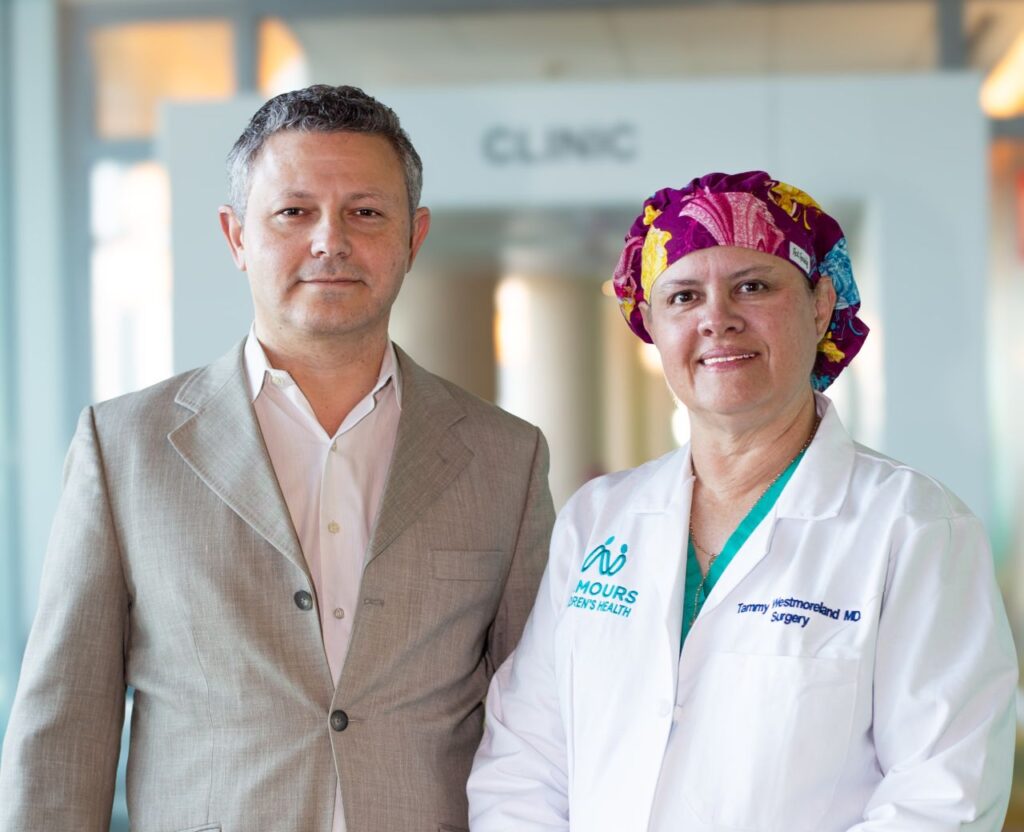New research indicates that injecting neuroblastoma tumors with Zika virus can shrink or eliminate those tumors in mice, suggesting that the virus could someday serve as an effective cancer therapy. This is newly published in the peer-reviewed journal Cancer Research Communications, from the American Association for Cancer Research.
On this week’s episode, we hear from the study’s lead, Dr. Tamarah Westmoreland, and first author, Dr. Joseph Mazar, both with Nemours Children’s Health, about this incredibly exciting research.
For more information, read the recent press release about the study.
EXCITING UPDATE – AUG. 20, 2024: Nemours Children’s received its largest donation to a single research project thanks to the Pass It On to Kids Foundation. Its $7 million donation will advance the groundbreaking research harnessing the Zika virus to target and eradicate neuroblastoma and ovarian cancers.
Guests:
Tamarah J. Westmoreland, MD, PhD, Associate Professor of Surgery, Nemours Children’s Hospital, Florida
Joseph Mazar, PhD, Research Scientist, Nemours Children’s Hospital, Florida
Producer, Host: Carol Vassar
EPISODE 49 TRANSCRIPT
Welcome to Well Beyond Medicine, the Nemours Children’s Health podcast. Each week we’ll explore anything and everything related to the 80% of child health impacts that occur outside the doctor’s office. I’m your host, Carol Vassar. And now that you are here, let’s go.
Music:
Well beyond medicine!
Carol Vassar, podcast host/producer:
Eight years ago, Zika virus was all over the news.
Speaker 3:
Zika virus is a virus that is spread to humans through the bite of an infected mosquito.
Speaker 4:
A new case of Zika virus was reported in Minnesota today.
Speaker 5:
Brazil is fighting the spread of Zika virus by trying to control its mosquito population.
Speaker 6:
Zika virus.
Speaker 7:
Zika virus.
Speaker 8:
Zika virus.
Carol Vassar, podcast host/producer:
Zika virus is back in the news, but for a completely different and much more promising reason. New research indicates that injecting neuroblastoma tumors with Zika virus can shrink or even eliminate those tumors in mice suggesting that the virus could someday serve as an effective cancer therapy in humans. This is newly published in the peer-reviewed journal Cancer Research Communications from the American Association for Cancer Research. With me to discuss what they found are the study’s lead author, Dr. Tamarah Westmoreland, and the study’s first author, Dr. Joseph Mazar, both with Nemours Children’s Health. Dr. Westmoreland kicks off our conversation with a primer on the cancer she and her team seek to better treat, neuroblastoma.
Dr. Tamarah Westmoreland, Nemours Children’s Health:
Neuroblastoma is a tumor that can occur all along the nervous tissue in the body, primarily up and down the spine, and also in the adrenal gland. It is called a neurocrest type tumor. And we see this more frequently in our younger children, especially in our younger like toddler age children.
Carol Vassar, podcast host/producer:
It is a cancer essentially.
Dr. Tamarah Westmoreland, Nemours Children’s Health:
It is a cancer. It can present in different ways. Like I mentioned, it can just be in the adrenal gland, the small gland above the kidney, or it can be at different parts along the spinal cord. Where it presents can affect what the patient looks like. Sometimes they can just have an enlarged abdomen, a mass in their abdomen, or sometimes they can have changes in how they walk. It can present in slightly different ways depending on where the tumor is.
Carol Vassar, podcast host/producer:
Neuroblastoma, what are the survival rates using the current treatments?
Dr. Tamarah Westmoreland, Nemours Children’s Health:
Neuroblastoma is broken into different risk groups and the risk groups that are the lower risk and the intermediate risk have great survival, greater than ninety-five percent, very good survival. However, the group of patients, which is about half of them that fall into the high-risk group, their survival is around 50%, with intense therapy involving chemotherapy, radiation, surgery, and we haven’t moved that number. That is why my lab, we focus on the high-risk neuroblastoma.
Carol Vassar, podcast host/producer:
Which brings us actually to the Zika virus. Now, last I had heard about Zika, it hit the news around twenty-sixteen.
Speaker 5:
The Zika virus has been linked to a birth defect called microcephaly, where babies are born with small heads.
Speaker 10:
With babies. Thousands have been born in Brazil with this birth defect and dozens have died.
Carol Vassar, podcast host/producer:
What is Zika virus and how did you come to examine this virus and research it as a potential life-saving treatment for neuroblastoma?
Dr. Tamarah Westmoreland, Nemours Children’s Health:
I think those are great questions. Zika virus is a mosquito-borne virus. And in general, you have very mild symptoms, cold-like symptoms, a mild rash. Matter of fact, many of us may have had Zika virus and didn’t even realize it. In the fetus, that’s a different story, and that’s why in that time, around 2016, especially in Miami, women were cautioned about that risk because Zika virus acts differently in the developing fetus as opposed to the fully developed baby and child and adult. In general though, it has very mild symptoms that are gone within two weeks.
As for how we came upon this, and I’ll let Dr. Mazar mention as well, but a paper came out around 2016, around the same time, that was studying Zika virus. That’s what its focus was. And it noted that for mature neurons, which are nervous tissue, that Zika virus didn’t have really much of an effect, if anything. However, in immature neurons, and those are going to be your neurons or nervous tissue that is in a development, like what you would see in a fetus, Zika virus was killing those tissue. And Dr. Mazar, do you want to comment a little bit about that paper as well?
Dr. Joseph Mazar, Nemours Children’s Health:
Sure. What the paper showed was that mature neurons were resistant to the virus, but immature neurons were wiped out. And this is in a mixed population, the virus is present and it’s not doing anything to the mature cells. And we asked the question, immature neurons are neuroblasts, and that is the cell that develops into a neuroblastoma. Neuroblastoma is simply a neuroblast that became a cancer. I asked the question, “If neuroblasts are sensitive, would neuroblastoma also be sensitive?” And we screened this and found absolutely in virtually every single case, the neuroblastomas are completely wiped out by the virus. And what we discovered in animals was that mature tissue in the animals shows the same resistance since the tumors are completely made up of these immature cells, the tumor gets completely wiped out and the mice are perfectly healthy.
Dr. Tamarah Westmoreland, Nemours Children’s Health:
I think that from that paper, like you mentioned the paper in 2018, and we all came together and looked at cell lines. These are just cells, not actual tumors grown in mice. And we just did the initial testing in 2018 to see, what happens when we add Zika virus to these cell cultures? And like we mentioned, that was published in 2018 and we expanded on that work in animals to look at when an actual tumor is grown on the side of the mouse, what happens when you inject Zika virus? And what we did is we injected Zika at the edge of the tumor and Zika virus essentially moved like a gradient across the tumor killing the tumor and leaving really just a small amount of scar that’s left.
And to make sure that we were not showing bias to this and though it was repeated in over 14 experiments, we did have one of our Nemours pediatric pathologist, Dr. Drehner, independently look at all of these samples and rate the histology showing that Zika virus had killed the tumor. And not only were we showing that the tumor was destroyed by Zika virus, we also studied these animals and allowed them to continue to live to show that there was a survival advantage to the mice treated with Zika virus as compared to the control. I think that this is very exciting results, especially in a tumor with only 50% overall survival.
Carol Vassar, podcast host/producer:
The research that you published in 2018 and the research that you are publishing now, what’s different now as opposed to 2018?
Dr. Tamarah Westmoreland, Nemours Children’s Health:
In 2018, that study was all in cells or cell culture. It was not in mice. And I think we get a lot of knowledge and insight when we work in cells, but sometimes the information that we learn in cell culture doesn’t translate to mice and may not translate to human. From 2018, our focus was, “Now we need to translate this into something that could actually help a patient.” That means moving into mouse model and essentially creating the experiments and the mouse model and everything and how do you inject Zika virus, how much do you inject?
All of this we had to determine to determine the exact amount to give, how to give it. And then like I mentioned, the survival studies. I will mention within the paper we do have a patient sample that is not a mouse sample. It is from an actual patient. And what we did is we took the patient’s tumor back to the lab and treated that tumor right away with Zika virus and within five days saw almost complete necrosis or killing of that tumor. The paper primarily is a mouse paper, but we do have a human sample within it as well.
Carol Vassar, podcast host/producer:
That is fabulous research and fabulous work. What is the implication for treating neuroblastoma in humans moving forward based on what you’ve discovered?
Dr. Tamarah Westmoreland, Nemours Children’s Health:
First of all, I want to say that we do need to do more research and study. We do need to work with safety profiles before we would move into humans. And some of that we have already started studying Zika virus in neuroblastoma grown in the mouse in the same location you would see in a child such as above the kidney or in that adrenal gland and working with a mouse with an intact immune system. We are already doing those studies. I think opining on where Zika virus could go. In the Children’s Oncology Group Protocol for high-risk neuroblastoma, there is a section at the beginning where the patient receives chemotherapy and then they have what’s called local control such as surgery or radiation. At the time of surgery, that is a potential opportunity to resect what can be resected of the tumor safely and inject Zika virus directly because this is not a systemic treatment that we’ve done in mice.
This is a local treatment, this is a local injection of the tumor. And in surgery, even if we resect all the tumor that we’ve seen, we know sometimes there are going to be tumor cells in that area, hence recurrence, that happens. And here’s an opportunity for Zika virus to address that tissue that remains with a direct injection of the tumor bed or the tumor itself at the time of surgery and effectively serving as a bridge therapy, meaning to help bridge the patient from that induction therapy to further therapy for high-risk, neuroblastoma.
Carol Vassar, podcast host/producer:
Dr. Mazar, is there additional research that needs to occur before we see a treatment for neuroblastoma in humans?
Dr. Joseph Mazar, Nemours Children’s Health:
Sure. There’s an awful lot of questions that we want to continue answering. One of which, for example, is the effect on chemotherapy resistance or in composite with chemotherapy treatment. Another is the effect of the immune system on the virus on either retaining it or side effects from it. Overwhelmingly in the mice we saw no side effects whatsoever. The mice were perfectly healthy, irrespective of the dose effectively. Again, the vast majority of people who get Zika are asymptomatic. We have very high hopes that it actually would be very similar. But in addition, there are additional experiments we want to perform such as, for example, orthotopic, which means, again, introducing a tumor in known locations that are similar to human cases.
Carol Vassar, podcast host/producer:
Dr. Westmoreland, same question for you, but from the medical perspective, what steps need to happen or occur before we see this possible treatment for neuroblastoma in humans?
Dr. Tamarah Westmoreland, Nemours Children’s Health:
I think that knowing the effect of the immune system by working with some of our immunocompetent mice that we do have those experiments ongoing is important because at the time of surgery, these children are not completely immunodeficient. We need to know more information about the immune system. And then like Dr. Mazar said, having the tumor in the location of where we see it in children is going to be very important to look at the effect of Zika virus on the surrounding organs as well. And we’re in the process of doing that experiment now.
Carol Vassar, podcast host/producer:
It sounds like Zika, it sounds like has a great potential with very few downsides, but there have to be some downsides. What do you foresee could be downsides in using Zika as a treatment?
Dr. Tamarah Westmoreland, Nemours Children’s Health:
One of the reasons that we like working with Zika is because of its mild symptoms. There is a risk of having cold-like symptoms when Zika is injected. Also, these experiments involve a single injection Zika virus. In a human, the child may require more than one injection. And how is that done? Can it be done percutaneously with the assistance of interventional radiology or would this have to be a surgical injection? I think those are questions that we would need to work out. But needing more than one injection is a possibility when we’re talking about human.
Carol Vassar, podcast host/producer:
Are we moving into human trials at this point or is there an interim step before we move into human trials? And how soon do you think all of this can be accomplished?
Dr. Tamarah Westmoreland, Nemours Children’s Health:
We definitely are not in human trials yet. And I would think that we need that information on our immune intact mouse with the tumor growing in the similar location as a child before we take that step into human trials. And timing is always hard because we want it yesterday. And I think this study definitely illustrates that you need to be methodical and careful when you’re doing the experiments to ensure that the data that you see is accurate and can be translated into humans. And timing wise, we are very hopeful in the near future that we would be able to progress to human clinical trials.
Carol Vassar, podcast host/producer:
Do either of you foresee this potential treatment being applied to treat other cancers or other tumors?
Dr. Tamarah Westmoreland, Nemours Children’s Health:
It’s funny you say that because we are looking at other tumors. Specifically, we look at a tumor called diffuse intrinsic pontine glioma, which is a deadly pediatric brain tumor. And we have found excellent results in mice with this and actually are in the process of expanding this work with intracranial work in the mice. Yes, and we have looked at other tumors that have good possibility. There are other groups outside of Nemours that looked at glioblastoma and that is published. Yes, there are independent groups outside of Nemours looking at this as well as within Nemours.
Carol Vassar, podcast host/producer:
When you look at your research going back, moving forward, how do you see this fitting into the idea of going well beyond medicine?
Dr. Tamarah Westmoreland, Nemours Children’s Health:
I think it’s looking at the patients who I take care of and saying, “I’m not just treating you today. I am planning for tomorrow.” And it may not be that particular patient sitting right in front of me, but it’s future patients who unfortunately could be in the same situation. It’s not just saying, “I am going to take care of your problem that’s going on this minute,” it’s that at Nemours we are planning for the future for less invasive treatment, for better treatment, and this is just an example of that.
Carol Vassar, podcast host/producer:
And for all children.
Dr. Tamarah Westmoreland, Nemours Children’s Health:
Yes, absolutely.
Carol Vassar, podcast host/producer:
Anything I haven’t asked that you’d like to share in this regard?
Dr. Tamarah Westmoreland, Nemours Children’s Health:
I think one thing I think both of us would say is this work would not happen without the dedication of Nemours Children’s Hospital to academic medicine and research. Not only at Nemours are we taking care of patients every day, but we’re also expanding the horizons. And in many areas in research, and this is just an example of that, we’re also very thankful to donors and grants that we have received that make this work possible. And also my entire team, Dr. Mazar, is with me, but there are also other team members who are part of my lab who work diligently to make this happen.
Music:
Well beyond medicine!
Carol Vassar, podcast host/producer:
Learn more about the incredible research being done by Dr. Tamarah Westmoreland, Dr. Joseph Mazar, and the entire research team at Nemours Children’s Health by visiting our website nemours.org. Thanks also to Dr. Westmoreland and Dr. Mazar for sharing their time and expertise. Our podcast home is nemourswellbeyond.org, where you may also find all of our past, present and upcoming podcast episodes. There, you may also subscribe to the podcast and leave a review. Our production team this week includes Cha Parker, Susan Masucci, Leah Goodwynne, and Cheryl Munn. Join us next time as we begin a series on what’s hot in neonatology with one woman’s compelling and personal NICU experience and how she’s working to support other families who find themselves unexpectedly caring for a preterm baby. I’m Carol Vassar, until next time, remember, we can change children’s health for good well beyond medicine.
Music:
Well beyond medicine!










